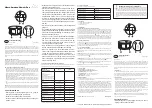
147
Programmable Hardware Manual (PHM)
© Tibbo Technology Inc.
·
GPIO 48 is the Data line; set it to the state that you wish the LED to be in, LOW
= ON, HIGH = OFF.
·
When you then pull GPIO 47 (Clock line) from its normal state (HIGH) to LOW and
then back to HIGH, the state of the Data line is read in and used for LED1.
·
If you want to turn on LED2 (for example) you have to set GPIO 48 to LOW,
toggle the clock once (HIGH-LOW-HIGH) which would set LED1 ON, set GPIO48 to
HIGH (because you want LED1 off) and then just toggle the clock again (HIGH-
LOW-HIGH). At this point, the state of LED1 would shift to LED2 (so LED2 would
light up).
So assuming that all LEDs are OFF and each row means that we have toggled
through one clock cycle:
Clock
cycle
Data
LED1
LED2
LED3
LED4
LED5
1
LOW
ON
OFF
OFF
OFF
OFF
2
LOW
ON
ON
OFF
OFF
OFF
3
HIGH
OFF
ON
ON
OFF
OFF
4
LOW
ON
OFF
ON
ON
OFF
5
HIGH
OFF
ON
OFF
ON
ON
As you can see, each clock cycle sets a new state for LED1 which directly
corresponds to the state of the Data line, and shifts all previous LED states.
Buzzer
The buzzer of the NB1000 is connected to the GPIO45/CO line of the onboard
Your application can control the buzzer through the "beeper" (beep.) object (see
TIDE, TiOS, Tibbo BASIC, and Tibbo C Manual). Recommended value for the
beep.divider property is 21600.
Ordering Info and Specifications
Model number
Description
NB1000
The NB1000 board with the
mounted on the NB1000 and connected to the latter
with the
If you wish to have Wi-Fi or GPRS ports on the NB board, please order the
product.
Hardware specifications
Ethernet interface
10/100BaseT Ethernet, Auto-MDIX
Supply voltage range
10-18VDC
Operating temperature
-30 to +80 degrees C
















































